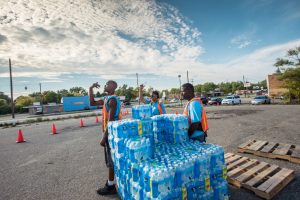26 December 2018
Consumer purchasing data shows locals’ response to water contamination
Posted by Lauren Lipuma

Water bottles at a “Water Pickup” location for citizens in Flint Michigan.
Credit: U.S. Department of Agriculture
By Bailey Bedford
Supermarket purchases show scientists how communities respond to health-related water quality violations, which could provide them with a new tool for monitoring public health concerns, according to new research.
Maura Allaire, a water economist at the University of California Irvine, and colleagues are turning to consumer purchasing data to help identify practical impacts of water contamination on people. In a new study, they saw increased purchases of bottled water and over-the-counter antidiarrheal medicine in areas where health-related violations of the Safe Water Drinking Act were reported.
The researchers obtained regional shopping data from the Nielsen Company, a global marketing research company. For reported water quality violations across the U.S., they looked at supermarket sales data in the affected county during the week of the violation. They searched for meaningful changes in the shopping patterns that could be explained by the contamination from the violation.
Allaire explained that using consumer purchases in an area may be a way of surveying potential health concerns without having to investigate at the individual level.
“This is a great way to capture consumer behavior in a quantitative way and to begin to say how can we do public health surveillance in a more comprehensive way,” said Allaire, who presented results of their work last month at the 2018 American Geophysical Union Fall Meeting in Washington, D.C.
The researchers investigated purchases of bottled water because people might buy it to avoid the impacts from the contaminated water. They also investigated antidiarrheal medicine as a product that might be purchased by those made sick by the water-safety violation.
They analyzed reported violations from 18,898 water systems in 2,151 different counties. The sales data they used included information about 90 different retail chains. Using these two data sources, they were able to show correlations between the product sales and reported violations.
The analysis showed an average increase of bottled water sales of about 14% for tier one violations. The EPA defines a tier one violation as “any time a situation occurs where there is the potential for human health to be immediately impacted, water suppliers have 24 hours to notify people who may drink the water about the situation.” The analysis also showed an average increase of antidiarrheal medicine of about 4% for tier one violations.
But these trends where not universal. The researchers saw no significant increase of bottled water sales for low-income, rural communities. Previous research indicates that such communities are also more likely to experience a violation.
The researchers’ analysis also revealed that the response was significantly less for tier 2 violations, which pose “immediate risk to human health” and only have to be reported within 30 days of the violation.
Allaire suspects this research may be expanded beyond revealing such trends and impacts. She thinks this approach may be used to draw attention to areas that need to be investigated for contamination.
“If you are able to capture this on a weekly basis, perhaps you can stay ahead of the curve,” Allaire said.
–Bailey Bedford is a graduate student in the Science Communication program at UC Santa Cruz. Follow him on Twitter at @BBedfordScience.


 GeoSpace is a blog on Earth and space science, managed by AGU’s Public Information staff. The blog features posts by AGU writers and guest contributors on all sorts of relevant science topics, but with a focus on new research and geo and space sciences-related stories that are currently in the news.
GeoSpace is a blog on Earth and space science, managed by AGU’s Public Information staff. The blog features posts by AGU writers and guest contributors on all sorts of relevant science topics, but with a focus on new research and geo and space sciences-related stories that are currently in the news.